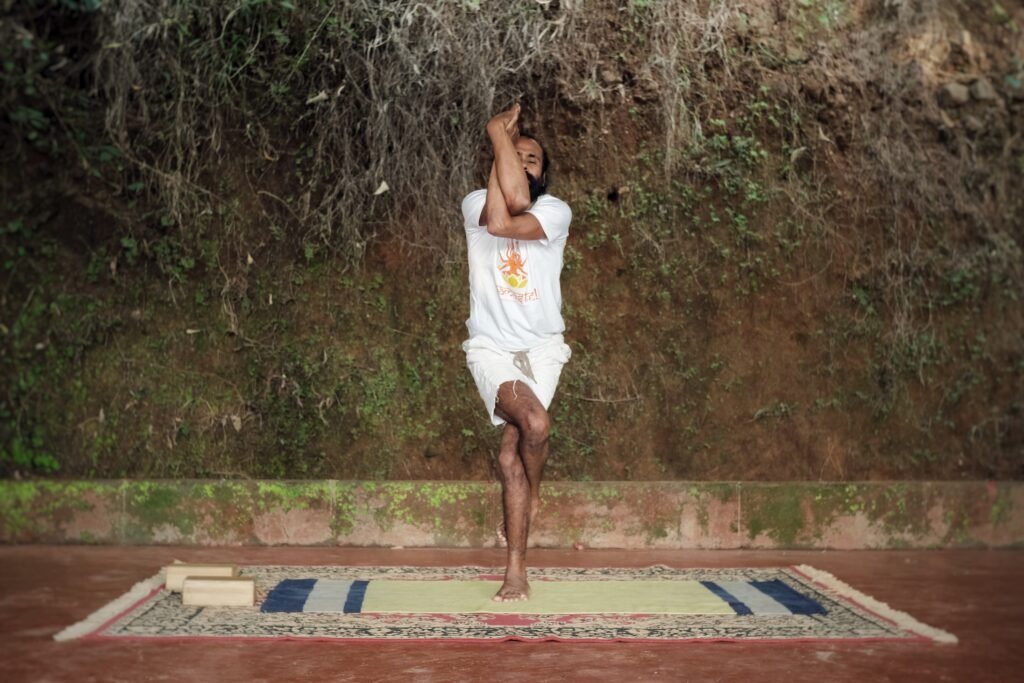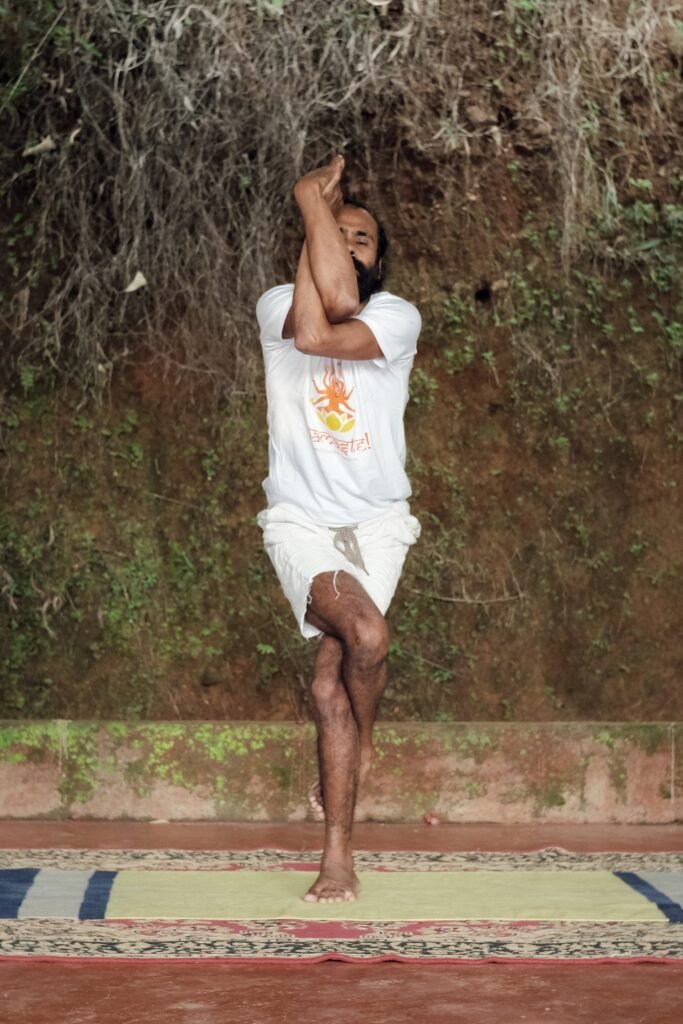
The term “asana” means “posture” in Sanskrit, and “garuda” means “eagle” in the name. The Garuda is regarded as the monarch of the birds.
This standing position strengthens the legs and is sometimes referred to as a balance pose.
(Garudasana) Eagle Pose Background:
Garuda is the king of birds and Lord Vishnu’s vahana. According to legend, Lord Vishnu bestowed a blessing on Garuda after being deeply moved by the strength and power he displayed.In response, Garuda enquired of Lord Vishnu how he may assist him.
Garuda agreed when Lord Vishnu asked him to serve as his vahana (mountain/vehicle) at that point.
According to legend, Garuda is both a human and a bird. His body is gold, and he has two hands in the Anjali Mudra while holding an umbrella and a jug of amrita with the other two. He has a kite’s beak, wings, and other body parts, including his breast and legs.
Garuda is represented by a variety of deities, including Khageswar (the king of birds), Suparna (someone with attractive features), Suvarnakala (with a golden body), and Nagantaka (devourer – enemy of all snakes).
GARUDASANA IN YOGA
Garudasana, sometimes called the Eagle Pose, is derived from the Sanskrit words “garuda” and “asana” (posture).
As the king of birds, his “eagle eyes” represent a clear vision, free from misinformation and misunderstanding, and peering directly into the reality of each circumstance.
One must prepare their body for Garudasana by applying Drishti (one focused attention) and unaffected attention to the breath. It is also a helpful technique for bringing your pupils’ minds to the present moment by removing them from ignorance, mental chatter, and ego.
When done mindfully, Garudasana promotes stability, tenacity, and core strength. Garuda symbolizes endurance, nourishment, and protection.
Yoga instructors can promote humility and a sense of gratitude in their pupils while instructing them in Garudasana.
Garuda is also likened to the sun and fire; thus, when performing Garudasana, the strength that the body and mind need should be used for the asana and for the benefit of all people.
While performing the pose, conscious of this will alter the mental attitude and infuse it with gratitude.

EAGLE POSE STEPS:
- Start by standing in Tadasana, also known as Mountain Pose, and taking a few deep breaths.
- Breathe as you lift your right foot off the ground and cross your right leg over your left leg just above the knee. Place the front of the left thigh on top of the back of the right thigh. Here, fully exhale while keeping an eye on the balance.
- Now, position the right foot so that the big toe of the right foot hooks just over the inside of the left ankle, and the right shin contacts the left calf. The right and left legs will be interlocked.
- When comfortable, sag your hips and hold your balance for a while.
- Raise the arms to chest height while bending the elbows.On the front of the right upper arm, close to the elbow joint, place the left elbow for support.Then, reposition the right hand to the left and the left to the right before joining the palms.The locked left arm encircles the right arm.
- Maintain a straight back while maintaining a focused gaze at a single place. Hold this position for a few seconds or six breaths, focusing on your core and drawing your navel in.
- Pay attention to your balance, stretch, body weight on each foot, breath, and gaze since these factors work together to keep you upright.
- Return to Tadasana (Mountain Pose) and unwind by relaxing the arms and legs.
- Repeat the position while standing on the right leg with the left foot interlocked behind the right calf and the right arm wrapped around the left arm. For greater balance, it’s vital to bring your attention from your core, and the more the legs are interlocked tight, the better the balance. Stay with the balance for roughly six breaths, ensuring the spine is straight as you lower your hips.
Advantages of Eagle Pose:
-
-
Helps Improve Body Balance:
-
The main goal of garudasana is to balance the body on one foot.
Even though it may be enjoyable to observe someone performing the stance, really performing it can only help you appreciate the amount of effort it demands.
The position aids in locating the stabilizer point in the middle of the body.
When you practice this posture in the morning, the calm air makes it easier to maintain the position for a long time and reap the most advantages.
-
-
Alleviates Sciatica
-
Due to the long hours spent sitting at a desk in today’s workplaces, sciatica is one of the most common ailments in modern day.
If not treated promptly, this could develop into an incurable illness.
Garudasana helps to treat sciatica by toning the lower bones in the hip area, which is achieved with practice.
-
-
Complete Body Stretching
-
With Garudasana, you may stretch in the best conceivable way.
Almost every joint in your body stretches from the knees to the shoulders when you are in the Eagle Pose. One of the finest methods to revitalize the body is stretching, which helps the muscles and bones repair.
-
-
Increases mental focus
-
In this unique position, it takes tremendous attention to keep the body from losing balance. Additionally, you practice breathing and mental exercises while performing the asana.
You become a highly intelligent person by sitting in meditation on one leg.
The focus strengthens the capacity for thought, while the mantras provide spiritual power.
-
-
Strengthens the bones in the legs
-
The bones of the legs are what support the entire weight of the body.
Especially the lower legs’ Tibia and Fibula. During the asana, bones suffer the most damage. Thus, by strengthening the pair, the Eagle Pose is the ideal approach to provide the legs strength and vitality.
-
-
It gives the body more flexibility
-
When one wants to become an athlete, flexibility is a key component of the human anatomy that must be at the top.
The body’s capacity to adjust to new circumstances and its physical surroundings is directly correlated with the amount of elasticity stored inside it.
-
-
Lengthens the thighs and arms
-
Nearly all of the body’s movements and activities depend on the sets of the arms and thighs, two of the most significant pairs of bodily parts.
It helps to release the body from contraction while rotating the legs and arms to improve posture.
Eagle Position (Garudasana) Contraindications:
Refrain from assuming this pose if you have knee, elbow, ankle, or wrist injuries. Not suitable for pregnant ladies.
FAQ:
-
- Which arm is uppermost in the eagle pose?
There is no absolute law. The arm of the opposing side goes on top of whichever leg is on top.
-
- When should one perform Garudasana?
This posture should be performed between 10 and 12 hours after eating for optimum outcomes, ideally in the morning before the first meal of the day.
-
- What is the benefit of the eagle pose?
Eagle Pose strengthens the thighs, hips, ankles, and calves while stretching the shoulders and upper back.
